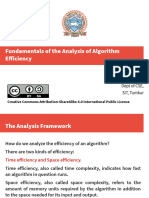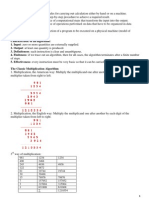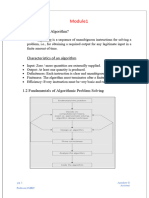Asymptotic Notation and Basic Efficiency Classes
Asymptotic Notation and Basic Efficiency Classes
Uploaded by
Sudhir VarmaCopyright:
Available Formats
Asymptotic Notation and Basic Efficiency Classes
Asymptotic Notation and Basic Efficiency Classes
Uploaded by
Sudhir VarmaOriginal Description:
Original Title
Copyright
Available Formats
Share this document
Did you find this document useful?
Is this content inappropriate?
Copyright:
Available Formats
Asymptotic Notation and Basic Efficiency Classes
Asymptotic Notation and Basic Efficiency Classes
Uploaded by
Sudhir VarmaCopyright:
Available Formats
lOMoARcPSD|34251814
Asymptotic notation and Basic Efficiency Classes
Analysis and Design of Algorithms (Jain (Deemed-to-be University))
Studocu is not sponsored or endorsed by any college or university
Downloaded by Sudhir Varma (sudhirvarma406@gmail.com)
lOMoARcPSD|34251814
16BCA5D11 ANALYSIS AND DESIGN OF ALGORITHMS
Asymptotic notation and Basic Efficiency Classes
Asymptotic Notation:
Asymptotic notations are the mathematical notations used to describe the running time of an
algorithm when the input tends towards a particular value or a limiting value. Execution time
of an algorithm depends on the instruction set, processor speed, disk I/O speed, etc. Hence, we
estimate the efficiency of an algorithm asymptotically.
Let t(n) and g(n) can be any nonnegative functions defined on the set of natural numbers. The
algorithm’s running time t(n) usually indicated by its basic operation count C(n), and g(n),
some simple function to compare with the count.
Different types of asymptotic notations are used to represent the complexity of an algorithm.
Following asymptotic notations are used to calculate the running time complexity of an
algorithm.
O − Big Oh
Ω − Big omega
θ − Big theta
Big Oh (O): Asymptotic Upper Bound
‘O’ (Big Oh) is the most commonly used notation. A function f(n) can be represented is the
order of g(n) that is O(g(n)), if there exists a value of positive integer n as n0 and a positive
constant c such that −
f(n)⩽ c.g(n) for n>n0 in all case
Hence, function g(n) is an upper bound for function f(n), as g(n) grows faster than f(n).
Example
Let us consider a given function, f(n)=4.n3+10. 4.n2+5.n+1
Considering g(n)=n3,
f(n)⩽ 5.g(n) for all the values of n>2
Hence, the complexity of f(n) can be represented as O(g(n)), i.e. O(4.n3)
V Sem, Dept of BCA 21
Downloaded by Sudhir Varma (sudhirvarma406@gmail.com)
lOMoARcPSD|34251814
16BCA5D11 ANALYSIS AND DESIGN OF ALGORITHMS
Omega (Ω): Asymptotic Lower Bound
We say that f(n)=Ω(g(n)) when there exists constant c that f(n)⩾ c.g(n) for all
sufficiently large value of n. Here n is a positive integer. It means function g is a lower bound
for function f; after a certain value of n, f will never go below g.
Example
Let us consider a given function, f(n)= 4.n3+10. 4.n2+5.n+1
3
Considering g(n)= , f(n)⩾ 4.g(n) for all the values of n>0
Hence, the complexity of f(n) can be represented as Ω(g(n)), i.e. Ω( 3)
Theta (θ): Asymptotic Tight Bound
We say that f(n)=θ(g(n)) when there exist constants c1 and c2 that 1.g(n)⩽ f(n)⩽ 2.g(n)
for all sufficiently large value of n. Here n is a positive integer. This means function g is a
tight bound for function f.
Example
Let us consider a given function, f(n)= 4.n3+10. 4.n2+5.n+1
3
Considering g(n)= , 4.g(n)⩽ f(n)⩽ 5.g(n) for all the large values of n.
Hence, the complexity of f(n) can be represented as θ(g(n)), i.e. θ(n3).
V Sem, Dept of BCA 22
Downloaded by Sudhir Varma (sudhirvarma406@gmail.com)
lOMoARcPSD|34251814
16BCA5D11 ANALYSIS AND DESIGN OF ALGORITHMS
Asymptotic Analysis
Solving Recurrence Equations
A recurrence is an equation or inequality that describes a function in terms of its value on
smaller inputs. Recurrences are generally used in divide-and-conquer paradigm.
A recurrence relation can be solved using the following methods −
Substitution Method − In this method, we guess a bound and using mathematical
induction we prove that our assumption was correct.
Recursion Tree Method − In this method, a recurrence tree is formed where each
node represents the cost.
Master’s Theorem − This is another important technique to find the complexity of a
recurrence relation.
General Plan for Analyzing the Time Efficiency of Recursive Algorithms
1. Decide on a parameter (or parameters) indicating an input’s size.
2. Identify the algorithm’s basic operation.
3. Check whether the number of times the basic operation is executed can vary on
different inputs of the same size; if it can, the worst-case, average-case, and best-case
efficiencies must be investigated separately.
4. Set up a recurrence relation, with an appropriate initial condition, for the number of
times the basic operation is executed.
5. Solve the recurrence or, at least, ascertain the order of growth of its solution.
V Sem, Dept of BCA 23
Downloaded by Sudhir Varma (sudhirvarma406@gmail.com)
lOMoARcPSD|34251814
16BCA5D11 ANALYSIS AND DESIGN OF ALGORITHMS
EXAMPLE 1: Compute the factorial function F(n) = n! for an arbitrary non-negative integer
n. Since n! = 1•. . . . • (n − 1) • n = (n − 1)! • n, for n ≥ 1 and 0!= 1 by definition, we can
compute F(n) = F(n − 1) • n with the following recursive algorithm.
ALGORITHM Factorial(n)
//Computes n! Recursively
//Input: A nonnegative integer n
//Output: The value of n!
if n = 0 return 1
else return Factorial(n − 1) * n
Algorithm analysis
For simplicity, we consider n itself as an indicator of this algorithm’s input size.
i.e. 1.
The basic operation of the algorithm is multiplication, whose number of
executions we denote M(n). Since the function F(n) is computed
according to the formula F(n) = F(n
−1)*n for n > 0.
The number of multiplications M(n) needed to compute it must satisfy the
equality
M(n − 1) multiplications are spent to compute F(n − 1), and one
more multiplication is needed to multiply the result by n.
Recurrence relations
The last equation defines the sequence M(n) that we need to find. This equation
V Sem, Dept of BCA 24
Downloaded by Sudhir Varma (sudhirvarma406@gmail.com)
lOMoARcPSD|34251814
16BCA5D11 ANALYSIS AND DESIGN OF ALGORITHMS
defines M(n) not explicitly, i.e., as a function of n, but implicitly as a function
of its value at another point, namely n − 1. Such equations are called recurrence
relations or recurrences.
Solve the recurrence relation M(n)=M(n-1)+1 , i.e., to find an explicit formula
for M(n) in terms of n only. To determine a solution uniquely, we need an initial
condition that tells us the value with which the sequence starts. We can obtain
this value by inspecting the condition that makes the algorithm stop its recursive
calls:
if n = 0 return 1.
This tells us two things. First, since the calls stop when n = 0, the smallest value
of n for which this algorithm is executed and hence M(n) defined is 0. Second, by
inspecting the pseudo code’s exiting line, we can see that when n = 0, the
algorithm performs no multiplications.
V Sem, Dept of BCA 25
Downloaded by Sudhir Varma (sudhirvarma406@gmail.com)
lOMoARcPSD|34251814
16BCA5D11 ANALYSIS AND DESIGN OF ALGORITHMS
General Plan for Analyzing the Time Efficiency of Non-recursive Algorithms
1. Decide on a parameter (or parameters) indicating an input’s size.
2. Identify the algorithm’s basic operation (in the innermost loop).
3. Check whether the number of times the basic operation is executed
depends only on the size of an input. If it also depends on some
additional property, the worst-case, average-case, and, if necessary,
best-case efficiencies have to be investigated separately.
4. Set up a sum expressing the number of times the algorithm’s basic
operation is executed.
5. Using standard formulas and rules of sum manipulation either find a
closed form formula for the count or at the least, establish its order
of growth.
V Sem, Dept of BCA 26
Downloaded by Sudhir Varma (sudhirvarma406@gmail.com)
lOMoARcPSD|34251814
16BCA5D11 ANALYSIS AND DESIGN OF ALGORITHMS
EXAMPLE 1: Consider the problem of finding the value of the largest element in a
list of n numbers. Assume that the list is implemented as an array for simplicity.
ALGORITHM MaxElement(A[0..n − 1])
//Determines the value of the largest element in a given array
//Input: An array A[0..n − 1] of real numbers
//Output: The value of the largest element in
A maxval ←A[0]
for i ←1 to n − 1 do
if A[i]>maxval
maxval←A[i]
End for
return maxval
Algorithm Analysis
The measure of an input’s size here is the number of elements in the array, i.e.,
n.
There are two operations in the for loop’s body: o The comparison A[i]>
maxval and o The assignment maxval←A[i].
The comparison operation is considered as the algorithm’s basic operation,
because the comparison is executed on each repetition of the loop and not
the assignment.
The number of comparisons will be the same for all arrays of size n;
therefore, there is no need to distinguish among the worst, average, and
best cases here.
Let C(n) denotes the number of times this comparison is executed. The
algorithm makes one comparison on each execution of the loop, which is
repeated for each value of the loop’s variable i within the bounds 1 and n
− 1, inclusive. Therefore, the sum for C(n) is calculated as follows:
V Sem, Dept of BCA 27
Downloaded by Sudhir Varma (sudhirvarma406@gmail.com)
lOMoARcPSD|34251814
16BCA5D11 ANALYSIS AND DESIGN OF ALGORITHMS
EXAMPLE 2:
Consider the element uniqueness problem: check whether all the Elements in a
given array of n elements are distinct.
ALGORITHM UniqueElements(A[0..n − 1])
//Determines whether all the elements in a given array are distinct
//Input: An array A[0..n − 1]
//Output: Returns “true” if all the elements in A are distinct and
“false” otherwise
for i ←0 to n − 2 do
for j ←i + 1 to n − 1 do
if A[i]= A[j ]
return 0;
end for
end for
Algorithm Analysis:
The measure of an input’s size here is the number of elements in the array, i.e.,
n.
There are two operations in the for loop’s body: o The comparison A[i]>
maxval and o The assignment maxval←A[i].
The comparison operation is considered as the algorithm’s basic operation,
because the comparison is executed on each repetition of the loop and not
the assignment.
The number of comparisons will be the same for all arrays of size n;
therefore, there is no need to distinguish among the worst, average, and
best cases here.
Let C(n) denotes the number of times this comparison is executed. The
algorithm makes one comparison on each execution of the loop, which is
repeated for each value of the loop’s variable i within the bounds 1 and n
− 1, inclusive. Therefore, the sum for C(n) is calculated as follows:
V Sem, Dept of BCA 28
Downloaded by Sudhir Varma (sudhirvarma406@gmail.com)
lOMoARcPSD|34251814
16BCA5D11 ANALYSIS AND DESIGN OF ALGORITHMS
Algorithm Analysis:
The natural measure of the input’s size here is again n (the number of elements in the
array).
Since the innermost loop contains a single operation (the comparison of two elements),
we should consider it as the algorithm’s basic operation.
The number of element comparisons depends not only on n but also on whether there
are equal elements in the array and, if there are, which array positions they occupy. We
will limit our investigation to the worst case only.
One comparison is made for each repetition of the innermost loop, i.e., for each value
of the loop variable j between its limits i + 1 and n − 1; this is repeated for each value of
the outer loop, i.e., for each value of the loop variable i between its limits 0 and n −2
Algorithm Design :
The important aspects of algorithm design include creating an efficient algorithm to
solve a problem in an efficient way using minimum time and space.
To solve a problem, different approaches can be followed. Some of them can be efficient
with respect to time consumption, whereas other approaches may be memory efficient.
However, one has to keep in mind that both time consumption and memory usage
cannot be optimized simultaneously. If we require an algorithm to run in lesser time, we
have to invest in more memory and if we require an algorithm to run with lesser memory,
we need to have more time.
V Sem, Dept of BCA 29
Downloaded by Sudhir Varma (sudhirvarma406@gmail.com)
lOMoARcPSD|34251814
16BCA5D11 ANALYSIS AND DESIGN OF ALGORITHMS
Problem Development Steps
The following steps are involved in solving computational problems.
Problem definition
Development of a model
Specification of an Algorithm
Designing an Algorithm
Checking the correctness of an Algorithm
Analysis of an Algorithm
Implementation of an Algorithm
Program testing
Documentation
V Sem, Dept of BCA 30
Downloaded by Sudhir Varma (sudhirvarma406@gmail.com)
You might also like
- AssocDev Slides March2020Document285 pagesAssocDev Slides March2020Sakthivel PNo ratings yet
- Design and Analysis of Algorithm Question BankDocument15 pagesDesign and Analysis of Algorithm Question BankGeo ThaliathNo ratings yet
- ASUS ROG N550JX Repair GuideDocument7 pagesASUS ROG N550JX Repair GuidememepiNo ratings yet
- Home Matters Report 2021Document36 pagesHome Matters Report 2021ABC Action NewsNo ratings yet
- Daa 1mark Questions and AnswersDocument12 pagesDaa 1mark Questions and AnswerskoteswararaopittalaNo ratings yet
- 2-CST3011 - Algorithms and Data Structures-Algorithm AnalysisDocument34 pages2-CST3011 - Algorithms and Data Structures-Algorithm AnalysisBen AiahNo ratings yet
- CS8451 DAA PartA Q&A-new PDFDocument20 pagesCS8451 DAA PartA Q&A-new PDFMohan DasNo ratings yet
- M01S03 Daa-Unit-1-Asymptotic AnalysisDocument25 pagesM01S03 Daa-Unit-1-Asymptotic AnalysisandroiconsNo ratings yet
- CORE - 14: Algorithm Design Techniques (Unit - 1)Document7 pagesCORE - 14: Algorithm Design Techniques (Unit - 1)Priyaranjan SorenNo ratings yet
- CS-DAA Two Marks QuestionDocument12 pagesCS-DAA Two Marks QuestionPankaj SainiNo ratings yet
- QuestionsDocument31 pagesQuestionsHithaishi BathuluriNo ratings yet
- DAA Unit - 1Document68 pagesDAA Unit - 1Avsec CseNo ratings yet
- Unit 1: Daa Two Mark Question and Answer 1Document22 pagesUnit 1: Daa Two Mark Question and Answer 1Raja RajanNo ratings yet
- DaaDocument15 pagesDaaSaravanan DevarajNo ratings yet
- Kcs-503: Design and Analysis of AlgorithmDocument222 pagesKcs-503: Design and Analysis of AlgorithmNandni AryaNo ratings yet
- Algorithm AnalysisDocument82 pagesAlgorithm AnalysisbeenagodbinNo ratings yet
- Cs 316: Algorithms (Introduction) : SPRING 2015Document44 pagesCs 316: Algorithms (Introduction) : SPRING 2015Ahmed KhairyNo ratings yet
- Design and Analysis of AlgorithmDocument29 pagesDesign and Analysis of AlgorithmManishNo ratings yet
- Unit Ii 9: SyllabusDocument12 pagesUnit Ii 9: SyllabusbeingniceNo ratings yet
- Unit 3 Mathematical Aspects and Analysis of Algorithms: StructureDocument22 pagesUnit 3 Mathematical Aspects and Analysis of Algorithms: StructureRaj SinghNo ratings yet
- Chapter 2Document68 pagesChapter 2Zutta BackupNo ratings yet
- CS6402 Design and Analysis of Algorithms Question BankDocument27 pagesCS6402 Design and Analysis of Algorithms Question BankRamesh Kumar MNo ratings yet
- DAA Unit 1Document15 pagesDAA Unit 1Pon MuruganNo ratings yet
- 2marks DAADocument9 pages2marks DAAmegharajendran184No ratings yet
- Design and Analysis of Algorithm Questions and AnswersDocument81 pagesDesign and Analysis of Algorithm Questions and Answershuzaifmanzoor988No ratings yet
- DAA Two MarksDocument16 pagesDAA Two Marksmskumar_meNo ratings yet
- Design and Analysis of AlgorithmDocument20 pagesDesign and Analysis of AlgorithmBhagirat DasNo ratings yet
- Design and Analysis of Algorithm Questions and AnswersDocument81 pagesDesign and Analysis of Algorithm Questions and AnswersjeevithaNo ratings yet
- Analysis and Design of Algorithms PDFDocument54 pagesAnalysis and Design of Algorithms PDFazmiNo ratings yet
- Module 1 AADDocument9 pagesModule 1 AADcahebevNo ratings yet
- Analysis of AlgorithmDocument31 pagesAnalysis of Algorithmsmtptesting021No ratings yet
- ADA Chap 2Document43 pagesADA Chap 2Ayesha AhmadNo ratings yet
- DAA Viva QuestionsDocument15 pagesDAA Viva QuestionsCareer With Codes100% (1)
- DAA Unit 1,2,3-1Document46 pagesDAA Unit 1,2,3-1abdulshahed231No ratings yet
- University Solution 19-20Document33 pagesUniversity Solution 19-20picsichubNo ratings yet
- Module 2Document7 pagesModule 2farispalayiNo ratings yet
- Algorithm: Definition (Algorithm) : An Algorithm Is A Finite Set of Instructions That, If Followed, Accomplishes ADocument22 pagesAlgorithm: Definition (Algorithm) : An Algorithm Is A Finite Set of Instructions That, If Followed, Accomplishes APk WrightNo ratings yet
- 3.3 Complexity of Algorithms: ExercisesDocument3 pages3.3 Complexity of Algorithms: Exerciseslixus mwangiNo ratings yet
- DAA-19-20Document21 pagesDAA-19-20rajesh.kumarcisceNo ratings yet
- DAA Sem ANSDocument70 pagesDAA Sem ANSdannic1405100% (1)
- Chapter # 3 Asymptotic AnalysisDocument25 pagesChapter # 3 Asymptotic AnalysisMURTAZANo ratings yet
- Data Structure and AlgorithmsDocument57 pagesData Structure and AlgorithmsfNxNo ratings yet
- SEM5 - ADA - RMSE - Questions Solution1Document58 pagesSEM5 - ADA - RMSE - Questions Solution1DevanshuNo ratings yet
- AlgorithmDocument12 pagesAlgorithmSahista MachchharNo ratings yet
- CS2251 Design and Analysis of Algorithms1QBDocument14 pagesCS2251 Design and Analysis of Algorithms1QBVjay NarainNo ratings yet
- Cs1201 Design and Analysis of AlgorithmDocument27 pagesCs1201 Design and Analysis of AlgorithmmaharajakingNo ratings yet
- Week2 Complexity AnalysisDocument74 pagesWeek2 Complexity Analysisiremaslan200313No ratings yet
- 103 Assymptotic NotationsDocument112 pages103 Assymptotic Notations36rajnee kantNo ratings yet
- Design and Analysis of Algorithms - VTU Life (20ebooks - Com)Document85 pagesDesign and Analysis of Algorithms - VTU Life (20ebooks - Com)rsi1272870% (1)
- On Interior-Point Methods, Related Dynamical Systems Results and Cores of Targets For Linear ProgrammingDocument11 pagesOn Interior-Point Methods, Related Dynamical Systems Results and Cores of Targets For Linear ProgramminginventionjournalsNo ratings yet
- CS8451 DESIGN AND ANALYSIS OF ALGORITHMS QUESTION BANK - Watermark PDFDocument47 pagesCS8451 DESIGN AND ANALYSIS OF ALGORITHMS QUESTION BANK - Watermark PDFneelakandan50% (2)
- DAA UNIT 1 (1)Document19 pagesDAA UNIT 1 (1)sudeepkusagattiNo ratings yet
- CS 6402 - Design and Analysis of AlgorithmDocument72 pagesCS 6402 - Design and Analysis of AlgorithmHamsa GirishNo ratings yet
- DAA UNIT IDocument16 pagesDAA UNIT IzaynabshamskhanNo ratings yet
- European SemiconductorDocument14 pagesEuropean SemiconductorSimbhu Ashok CNo ratings yet
- Algorithms AnalysisDocument25 pagesAlgorithms Analysislyhoangkhang831No ratings yet
- Module 1Document11 pagesModule 1Ms Anushree GNo ratings yet
- Nonlinear Programming Based Sliding Mode Control of An Inverted PendulumDocument5 pagesNonlinear Programming Based Sliding Mode Control of An Inverted Pendulumvirus101No ratings yet
- DS PPTS - 2 PDFDocument653 pagesDS PPTS - 2 PDFMd kashifNo ratings yet
- Analysis and Design of Algoritms Wk 1-4Document47 pagesAnalysis and Design of Algoritms Wk 1-4roman.njorogeNo ratings yet
- DAA Notes CompleteDocument242 pagesDAA Notes CompleteVarnika TomarNo ratings yet
- मूल अधिकार (fundamental right) - 231024 - 135458Document19 pagesमूल अधिकार (fundamental right) - 231024 - 135458Sudhir VarmaNo ratings yet
- DAA Question BankDocument12 pagesDAA Question BankSudhir VarmaNo ratings yet
- Affiliation-Fee-Rules - 16 12 13Document4 pagesAffiliation-Fee-Rules - 16 12 13Sudhir VarmaNo ratings yet
- Format MtechDocument10 pagesFormat MtechSudhir VarmaNo ratings yet
- Ev2 Maths WorksheetDocument12 pagesEv2 Maths WorksheetSudhir VarmaNo ratings yet
- AC Servo Drive: Operation ManualDocument116 pagesAC Servo Drive: Operation ManualjassemNo ratings yet
- 01) Sahil Goyal - FDI IN RETAILDocument7 pages01) Sahil Goyal - FDI IN RETAILpriyankaNo ratings yet
- Appointment Letter - DraftDocument5 pagesAppointment Letter - DraftKarishma ParekhNo ratings yet
- Vantage Africa Certified Monitoring and Evaluation Course OutlineDocument4 pagesVantage Africa Certified Monitoring and Evaluation Course Outlinemakerd605No ratings yet
- Eco Indicator Calculation RIADocument11 pagesEco Indicator Calculation RIAStefan GabureanuNo ratings yet
- How To Get Pipe DevelopmentDocument4 pagesHow To Get Pipe DevelopmentpeymanNo ratings yet
- Vikas Kumar - Recruitment-5Document3 pagesVikas Kumar - Recruitment-5Shruti SharmaNo ratings yet
- L577-User Manual For Hardware PDFDocument30 pagesL577-User Manual For Hardware PDFLe Chi PhamNo ratings yet
- Addis Ababa University Electronic Library Thesis and Dissertation PDFDocument4 pagesAddis Ababa University Electronic Library Thesis and Dissertation PDFAddison Coleman100% (2)
- AO Trauma Asia Pacific Course Calendar 2024Document7 pagesAO Trauma Asia Pacific Course Calendar 2024prajwal guptaNo ratings yet
- Tutorial Pipeline SystemsDocument48 pagesTutorial Pipeline SystemsHarry PiyoNo ratings yet
- 9 Speed TransmissionDocument9 pages9 Speed TransmissioniwearnexusNo ratings yet
- WSZ Controller: For FUJI Inverter and Servo SystemDocument12 pagesWSZ Controller: For FUJI Inverter and Servo SystemAtiqur Rahman AtiqNo ratings yet
- Module 1 PDFDocument56 pagesModule 1 PDFAli khanNo ratings yet
- Restaurant Monthly Profit and Loss StatementDocument17 pagesRestaurant Monthly Profit and Loss StatementMozitom100% (1)
- 5418Buy ebook The Enduring Vision A History of the American People 6th Edition Paul S. Boyer cheap priceDocument71 pages5418Buy ebook The Enduring Vision A History of the American People 6th Edition Paul S. Boyer cheap priceunyceuloko100% (2)
- Resume Format For Student's PlacementsDocument3 pagesResume Format For Student's PlacementsPrachi SinghNo ratings yet
- Radix Products v. Atziloose - ComplaintDocument72 pagesRadix Products v. Atziloose - ComplaintSarah BursteinNo ratings yet
- PACKAGINGDocument10 pagesPACKAGINGEuge MansillaNo ratings yet
- Executive Engineer Assistant Engineer MPPKVVCL City Dn. West - Indore MPPKVVCL. Airport Zone INDOREDocument21 pagesExecutive Engineer Assistant Engineer MPPKVVCL City Dn. West - Indore MPPKVVCL. Airport Zone INDORERAKESH KUMARNo ratings yet
- High CourtDocument4 pagesHigh CourtKapil KhedekarNo ratings yet
- Effect of Tribo Layer Onsliding Wear Behaviour of Detonation Sprayed Alumina-Titania CoatingsDocument10 pagesEffect of Tribo Layer Onsliding Wear Behaviour of Detonation Sprayed Alumina-Titania CoatingsGopal krishnaNo ratings yet
- SQC Notes 2018 AdminDocument9 pagesSQC Notes 2018 AdminAby MathewNo ratings yet
- Molecular BiologyDocument17 pagesMolecular BiologyMirali SahuNo ratings yet
- Eu & me-NA0422312ENNDocument84 pagesEu & me-NA0422312ENNeanahanaNo ratings yet
- 2022 HTT451 Topic 3Document25 pages2022 HTT451 Topic 3Hanisah Ma'amorNo ratings yet
- Arabia FinalsDocument11 pagesArabia FinalsAlexis CarbonNo ratings yet






























































































